
The future of food lies in plants, says Spanish chef Rodrigo de la Calle, a vegetable visionary
The idea for De la Calle’s extreme plant-focused cuisine was first sown in China and although it didn’t take root he learned valuable lessons in Beijing that he took back to his homeland, where it blossomed
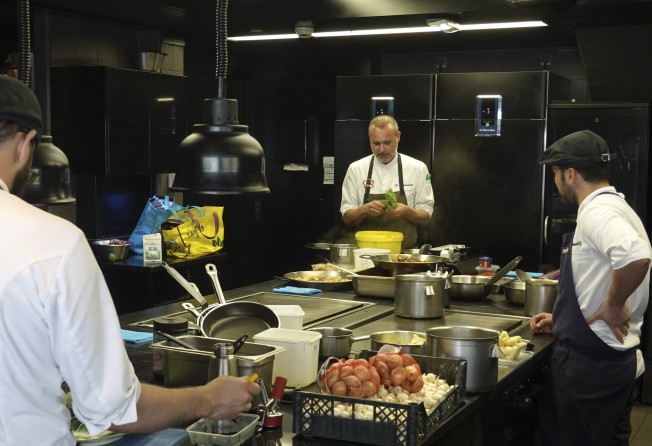
El Invernadero sits at the top of Calle Ponzano, a trendy street synonymous with tapas and cocktails in Madrid’s central Chamberí neighbourhood. Its block, though, is quiet and nondescript. From the outside, chef Rodrigo de la Calle’s Michelin-starred restaurant is rather inconspicuous; inside, understatement – not minimalism – reigns. The dining room is intimate and stylish, with leafy plants and glazed, apple-green wall tiles offsetting speckled white walls and bare, dark wood tables. The atmosphere is relaxed and unfussy. Piped birdsong plays on the sound system.
Under a steel framework that reflects the restaurant’s name (“The Greenhouse”) are five tables plus three high tables with stools. Together they seat just 16 diners. An open kitchen runs along one side of the rectangular room, offering wide views of the crew of eight plus a couple of training students at work.
There is no maître d’ or hostess, instead the 43-year-old de la Calle, in a fitted white chef’s jacket, trainers and warm smile, welcomes many of the arrivals himself. While it is clear the Spaniard is breaking many accepted norms of fine dining, the absence of hushed awe, obligatory reverence and culinary pretension that many Michelin-starred establishments exude still feels unexpected.
The first indication that something very different lies ahead comes with the bread and water: a warm, round loaf filled with roasted cherry tomatoes and generously dusted with lycopene, the natural pigment that makes tomatoes red, and a simple, unglazed terracotta cup filled with water spiked with phycocyanin, a blue pigment-binding protein from microalgae.

El Invernadero has no waiters. The cooks deliver the dishes themselves. Moments later my cook-server returns carrying a giant green candelabra-like stand with the first bocados (snacks). Perched on its wiry metal branches are encurtidos (pickled vegetables), including a succulent radish with a leaf of pinkish-purple-veined fittonia (nerve plant). Following these are a trio of hot tapas: kimchi empanada with huacatay (Peruvian black mint), a rolled petit four of celeriac filled with mushrooms and chlorella algae, and a perfectly spherical croqueta that explodes with liquidy spinach and kale when bitten into.
Course after course of vegetable – though not necessarily vegetarian or vegan – dishes arrive in rapid succession, each seemingly bolder and more impressive than the last. A tartar of beets, apples and avocado is topped with a foam made with forest berry vinegar, decorated with edible flowers, and served on raw beetroot in a soil-filled pot. A quartet of inch-high salsify roots stands in a pool of salsify escabeche sauce, crowned with trout eggs, capers and a pair of fresh vine leaves. Stewed pochas white beans come with rounds of “black sausage” made from eggplant and nuts.
A thick and creamy “soup” of black garlic, rutabaga and smoked tofu is topped with bright purple borage blossoms. A wedge of boletus mushroom lies on a bed of acorns and smouldering sprigs of fresh rosemary and thyme that emit a faint haze of aromatic smoke; a streak of apple kefir and three types of algae run alongside the fungi to contrast its earthy flavour.
With a trimmed salt-and-pepper beard and easy charm, de la Calle frequently passes through the dining room to chat with guests. He is articulate and clearly accustomed to explaining not just the dishes but the philosophy behind his cooking.
Vegetables are at the centre of his vision, with animal protein – juices, broths, fats – playing a minor, supporting role when required to enhance the flavour or structure of a dish. De la Calle takes a comprehensive approach to vegetables, and includes seeds, roots, stems, leaves, bulbs, buds, flowers and fruits, each offering its own texture and flavour. To these he adds fungi, algae and even lichen (“a symbiosis between fungi and algae, it tastes a bit like the earth and a bit like the sea”, as he once described it).
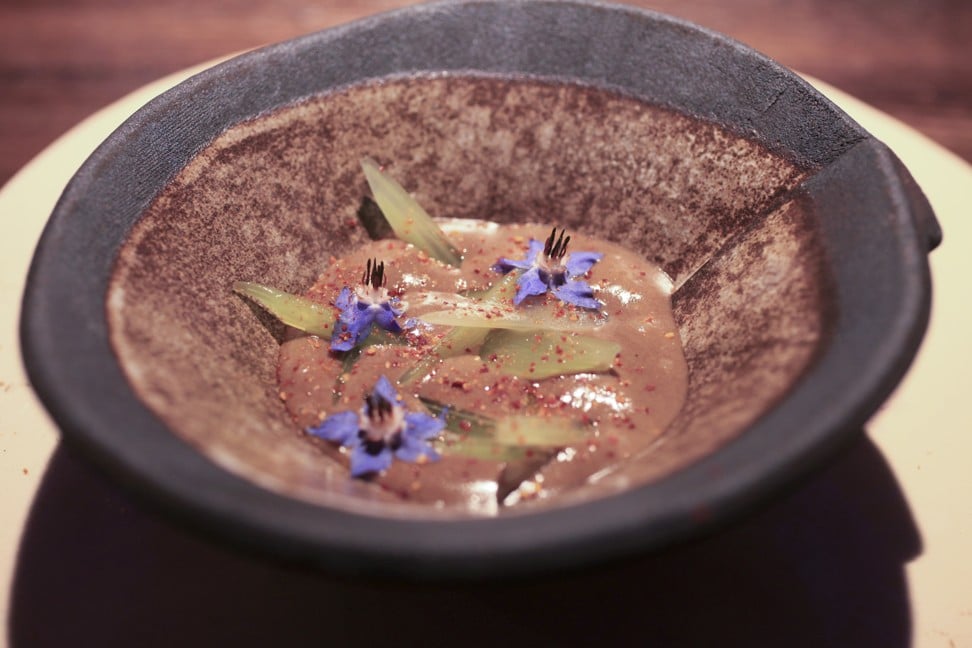
De la Calle’s extreme vision of root-to-flower was sown decades ago. He first attempted to put it into practice in Beijing, half a dozen years ago, and failed – though it didn’t end his work there, and he retains a presence both on the ground in China, with two Puerta 20 restaurants in the capital, and in the skies above it, where his meals are served by Air China. He ultimately succeeded with El Invernadero back in Spain with the help of new tools – fermentations, techniques, ingredients – garnered on his Chinese travels.
I first sampled de la Calle’s cooking this summer in Monaco. He had shuttered his Madrid restaurant and brought his team to Monte Carlo for a two-month-long alfresco pop-up in the luxurious Hôtel Métropole, home to a trio of Joël Robuchon restaurants. I had gone to dinner expecting to be wowed by his haute vegetable cuisine. And indeed I was.
But what I glimpsed that sweltering evening in Monte Carlo, and then fully experienced in his Madrid restaurant this past autumn, was more than a cocina verde (green kitchen): it was a revolución verde. It was the future of cooking. Robuchon – “chef of the century” and holder of the most Michelin stars in the world (the Frenchman held 31 at the time of his death in 2018) – certainly thought so, telling de la Calle, “You are making food that people will be eating in 20, 25 years.” Towards the end of his life, Robuchon became a strong advocate for healthier eating. “I am very interested in vegetarian food,” he told the Michelin Guide in an interview published a month before he died. “People want to eat more vegetables, that’s the upcoming trend. It’s not even a trend, but a necessity of the future.”
De la Calle’s link to vegetables runs unusually deep. It is in his DNA.
His father was a farmer, and until de la Calle was 14 years old, he moved schools three times a year to follow the harvests: autumn in Castilla-La Mancha for corn, Andalusia after Christmas for olives, and spring and summer for vegetables in their huertas an hour south of Madrid, in Aranjuez.
“My father taught me to eat what there is in each season, to understand each season, to respect each of the seasons,” de la Calle says. And on his mother’s side there were a number of cooks, as his grandparents had owned a hotel and restaurant. (They sold it when de la Calle was born.) In his house, gastronomy and agriculture were “el orden del día”, what they did and talked about every day. From early on he also had a clear-eyed, first-hand understanding of the efforts involved in growing food. Nothing in his family’s kitchen was wasted.

Rodrigo wanted to be a chef not a farmer. “When I told [my family] that I wanted to be a cook, they forbade me, and I started studying at the city’s hostelry school without my parents knowing about it.”
At 18 he left home and spent the next dozen years working in 35 different establishments, from local pizzerias to the workshop of master confectioner Paco Torreblanca to the Michelin-starred restaurants of many of Spain’s most innovative and celebrated chefs, including Andoni Luis Aduriz’s Mugaritz, Quique Dacosta’s El Poblet and, with particularly lasting influence, Martín Berasategui’s eponymous three-star establishment in the Basque country.
By then de la Calle was 30. He was ready to have his own kitchen. In 2006, he opened an eponymous restaurant in Aranjuez. He worked hard and gained, eventually, a Michelin star, awarded to him in the 2012 edition. It was a young chef’s dream. Yet he wasn’t completely happy. “I wanted to cook vegetables,” he says. “No one wanted vegetables.” They wanted meat. “In Spain you eat meat and fish every day. And vegetables are something that accompany fish or meat.” And this is especially true when people go to restaurants.
In the summer of 2013, he took an executive chef’s job in Madrid at the Hotel Villa Magna, one of Spain’s top properties. Critics, food bloggers and diners eagerly anticipated what he would do in the capital with access to better financial resources. It was the summer that Real Madrid football club signed Welsh winger Gareth Bale for a then-world record transfer fee, and the gastronomic press spoke in terms of de la Calle’s move as the city’s other fichaje estrella (“star signing”).
It was impossible, though, to run both establishments. (His work at the Villa Magna also included the hotel breakfast, in-room dining and food in the lounge and bar.) Less than a year later, he closed his Aranjuez restaurant to focus on Madrid.
Of course it was sad to shut what had been the place of his first struggles and successes, he said at the time. “But it is not a closure, rather it is a move, like moving houses. I’ve taken everything I’ve learned here, which is the most important thing.”

However, just two weeks later the hotel and chef ended their relationship. It was a low moment. But two important things happened. He began working with Robuchon and spent the next five years creating vegetarian and gluten-free dishes for the French chef’s many establishments, including L’Atelier de Joël Robuchon in Hong Kong (three Michelin stars), its sister establishment in Shanghai (two stars) and Robuchon au Dôme in Macau (three stars).
And he went to China.
In 2013, de la Calle landed in Beijing to do an event for a large Spanish agricultural company. He prepared a menu of vegetable dishes that particularly impressed one individual, who offered the Spaniard the chance to set up a restaurant in the Chinese capital.
Within months, de la Calle was attempting to implement his gastronomic vision in Beijing’s popular Sanlitun area. It didn’t go well. “They didn’t understand how a guy who is a vegetable specialist could come to China to cook vegetables, because the vegetable experts are the Chinese,” he says. “Everyone asked, ‘Why is a Spanish chef in China not cooking Spanish food?’” People expected him to prepare paella, gazpacho, tapas and sangria.
Yet it wasn’t the end of his work in China.
On one of his last nights before leaving the country, he met the proprietors behind the restaurant at the entrance of the Workers’ Stadium, home to the Beijing Guoan football club. (Its owners include actor Dai Jun, singer Jin Haixin and international footballer Shao Jiayi.) In 2016, he became the executive chef of Puerta 20, offering not haute vegetable cooking but modern, upscale Spanish cuisine. This time it was a success. In 2017, a second branch opened in the hip neighbourhood of Luomahu (Roma Lake).
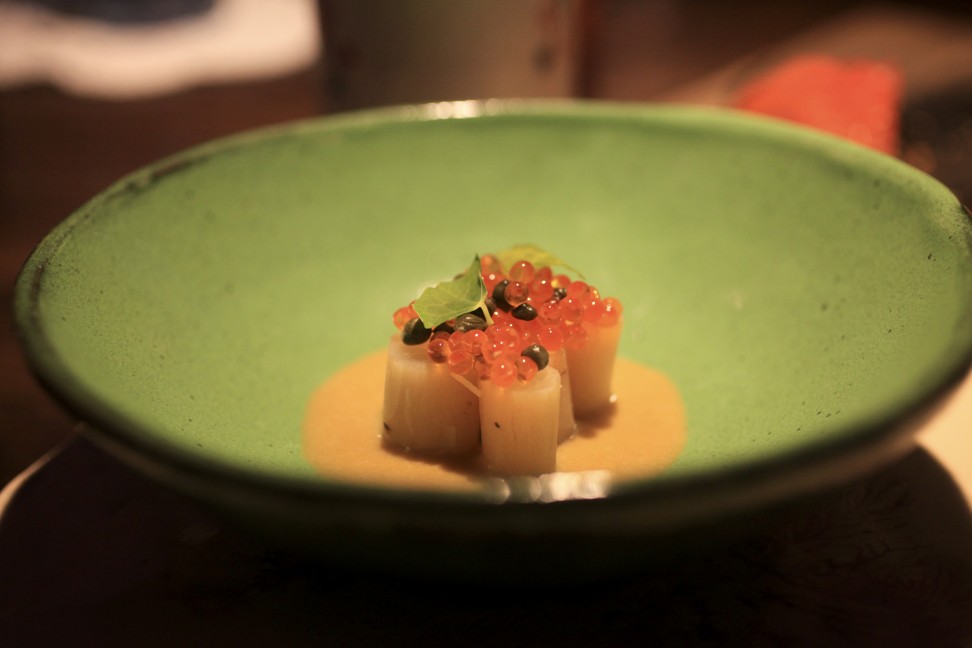
Last year, he began working for Air China creating business- and first-class menus – the first Western chef to do so for the national carrier. His creations are served on routes to Spain, but this year will expand to some other national flights.
China marked an important step not only in de la Calle’s trajectory as a businessman, but also his evolution as a chef.
“I am a better cook since I began going to China,” he says. “I have learned so much, and I am still learning so much. Chinese cuisine has completely influenced my cooking.”
Standing in the kitchen of El Invernadero before a midweek dinner service, he elaborates on what he has gleaned in China, from different fermentation techniques to spicing to cooking with a wok (for which he built a dedicated high-powered burner).
“In everything,” he says, turning towards the row of stoves. “In how to extol vegetables and not mask them, especially many cooking techniques, for example how to make fermented sauces from vegetables. We have managed to make the typical French demi-glace – a reduction of meat juices – with only vegetables.” He dips a spoon into a small saucepan, and raising it, lets some deep-brown sauce dribble off the end. Made from celeriac, it has the same depth and richness as a traditional demi-glace, the same feel in the mouth.
His range of ingredients continues to expand from exploring China, which he calls “the world’s largest pantry”. That includes learning how to use certain plants that seem to have little gastronomic value.
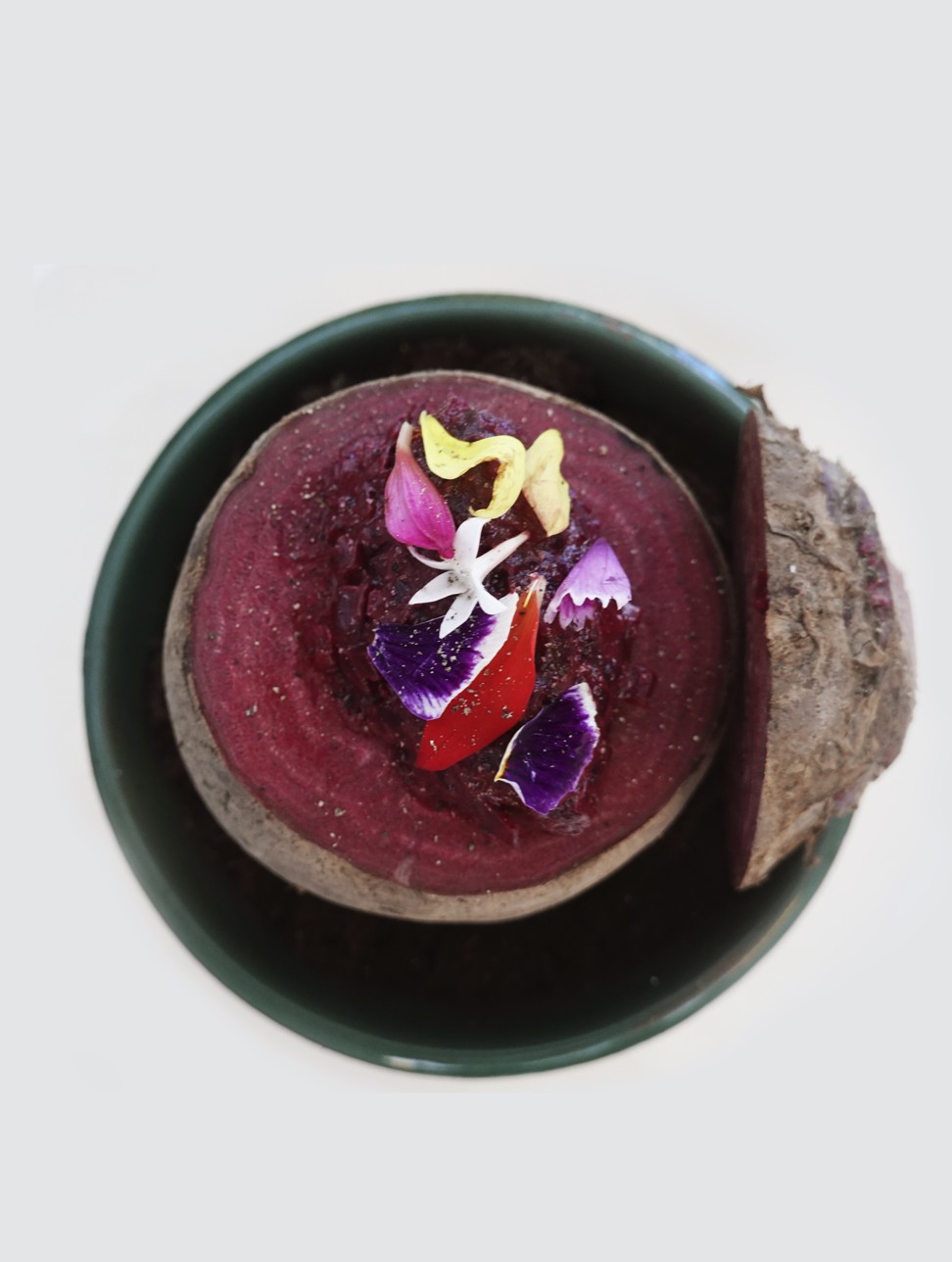
“It is revolutionary to take some vegetables that only animals would eat and transform them into a gourmet dish. It’s amazing.” De La Calle found that certain techniques used to do this are commonplace in China and taken for granted by cooks there. “But to us [Western chefs] it is magic. It awakens our creativity. Just as magical or more than when Ferran Adrià and elBulli came out every day with a new technique. I paid [particular] attention because I was looking for dishes with vegetables, not meat.” Every time he goes, he brings back something new.
After the failure of his first Beijing restaurant, he began imagining a venue that would encapsulate ideas he had been developing over the years. “For a while now,” he wrote in his 2017 cookbook, Cocina Verde, “I’ve had the feeling that vegetables have always been there for us, but we have never taken advantage of them.” Vegetables would take the starring rather than supporting role; they would be the protagonists. But it wouldn’t be a vegetarian restaurant. Rather, it would be a celebration of vegetables for omnivores. Certainly the great Robuchon, who saw the shift in people wanting to eat good food as well as healthy food, tipped his toque in approval.
De la Calle was 40. He was more mature, more experienced and had learned that running a restaurant was often about solving problems. He was not the same person he had been when he opened his first restaurant in Aranjuez. Nor was he the same chef. He had gained important new tools in China and elsewhere on his travels to help fulfil his plant-focused culinary vision.
In 2015, he opened a four-table restaurant that could serve eight diners in a boutique hotel in the Sierra mountains an hour north of Madrid. He named it El Invernadero. “I called it that because greenhouses were created to protect plants from the inclemencies of the weather,” he said last year in an interview with Guía Repsol, Spain’s equivalent of the Michelin guide. “After all that had happened, I was looking for a place like that to take refuge from the inclemencies of life.”
The restaurant quickly earned a Michelin star. “Flavour, fantasy and a delicate touch are to the fore here,” the inspectors wrote. In the spring of 2018, de la Calle transferred the restaurant to Madrid with double the number of tables. “Chef Rodrigo de la Calle is back in the Spanish capital!” the Michelin inspectors wrote in the next edition of the guide, breaking with their usual restrained tone. He retains his star in the 2020 guide.
The only way to solve climate change is to stop eating so much meat, so much fish. The meat industry and the fishing industry are ruining everything
The savoury courses of my “vegetalia” tasting menu end with a moist rice dish under a foamy blanket of wild mushroom “air” and garnished with pearly green dollops of pine tree aioli. A cheese plate and three different desserts follow. My cook-server duly describes each, but with many uncommon ingredients, I find it hard to always fully grasp the explanation of what she has set down before me. I have no help from a menu, which only comes with the bill at the end of the meal because de la Calle doesn’t want diners anticipating what lies ahead while they eat.
When I finally open the menu on the subway back to my hotel, it offers few clues. Inside a small folder sealed with green wax is a half sheet of paper printed using phycocyanin. The sheet lists only a pair of ingredients for each dish but gives no sense of their form and certainly not their complexity: nabo – menta [turnip – mint]colinabo – acedera [celery root – sorrel] col china – huacatay [nappa cabbage – Peruvian black mint]achicoria – shimeji [chicory – shimeji mushrooms]
According to my notes, there were 18 dishes over the three-hour-long meal. About halfway through I wanted it to stop. Not because I’d had enough. But because I knew that the impact and impressions of what I was eating would be buried under those of the next one. Every bite I ate felt original, felt worth taking the time to appreciate not only the ingredients and techniques that went into creating the dishes but also the thinking behind them.
Gastronomy, de la Calle believes, is more than just eating. And El Invernadero is more than just the dishes I was being served. “We are defending a new concept and a different way of understanding gastronomy,” he said in a recent interview. In the face of the climate crisis, it is an approach to eating that doesn’t focus on farm-raised animals or those from the sea.
De la Calle is neither vegetarian nor vegan, though his own diet is largely plant-based. “I cook vegetables because I love vegetables.” For him, the choice should be gustatory rather than ideological.
That said, he strongly advocates a healthier diet. And he is deeply concerned about the amount of greenhouse gas emissions caused by livestock. “In the same way that people look today at plastics, they will see farm-raised meat,” he tells me in Monaco. In Madrid, he goes further. “The sea is screwed because it is full of boats fishing in it. The only way that the sea can get better is to stop going into the sea to fish. And the only way to solve climate change is to stop eating so much meat, so much fish. The meat industry and the fishing industry are ruining everything.”
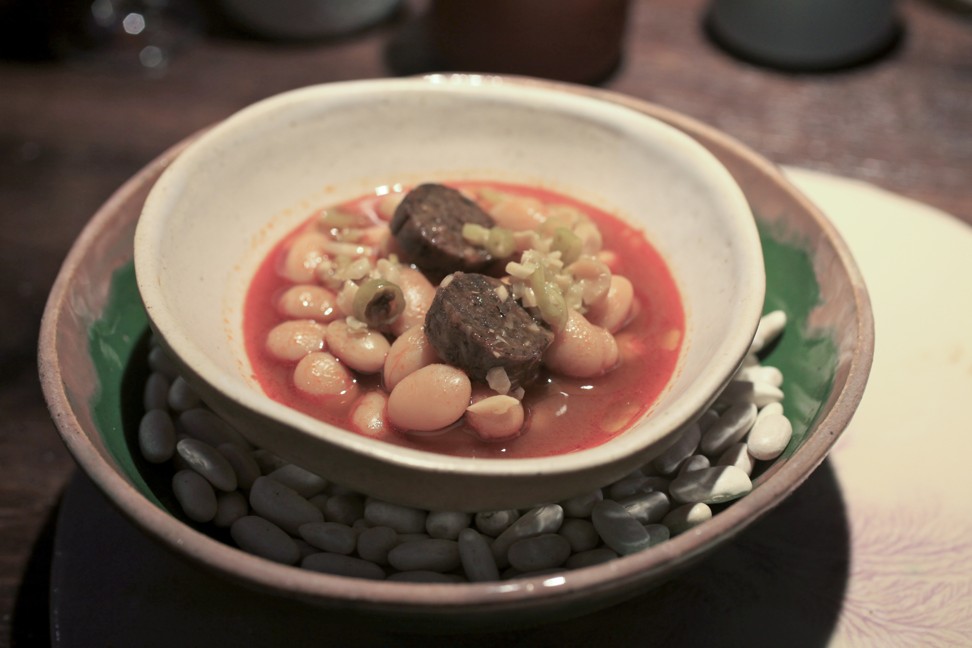
Globally, rather than reducing our intake of farm-raised meat, seafood and milk, consumption is growing with increased prosperity in the developing world. He does not insist that people stop eating meat completely, but rather that we look deeper into the plant kingdom’s offerings. With the botanist Santiago Orts, de la Calle developed the concept of gastrobotánica, which fuses gastronomy and botany and taps little known or little used products. While many other chefs are preparing dishes with vegetables, few are probing as deep into the plant world’s largesse.
“We use only 5 per cent of the varieties of vegetables on the planet. And of those, 95 per cent are only 10 varieties: potatoes, oranges, carrots, onions, pumpkins, pears, bananas, tomatoes …” The trend is accelerating, as large companies look to varieties that are higher yielding, cheaper to produce and more perfect looking on supermarket shelves, often with little consideration to flavour.
Of course, high-yielding food is necessary to feed and nourish a crowded planet, but de la Calle’s ideology is not radical either. He works closely with growers across Spain, and makes changes to his tasting menus not on the standard quarterly seasonal rotation, but as products arrive in the kitchen. With these he creates new dishes that he works into El Invernadero’s offerings.
Healthy haute cuisine is virtually an oxymoron, with many still considering ingredients such as foie gras essential on a fine dining menu. Yet de la Calle has managed to break the glass wall between Michelin-class cuisine and healthy dining. His “green revolution”, the 2020 Michelin guide acknowledges, “has broken down borders”.
But he has also offered a blueprint to a broader movement of strident flexitarianism that makes fuller use of the plant world. It is food governed by nature and by season.
People may want to eat fish, meat and shellfish now, Robuchon told de la Calle, but that will change. “When you are finishing your career, when you are retiring, there will be thousands [of cooks] like you.”

The work for such change, de la Calle says, is with the young in schools. It means educating a new generation about the vegetable world and its still largely untapped culinary possibilities.
The final dish my cook-server brings to my table is a mini carrot cake; a creamy, crown-shaped treat topped with camu camu berries and bright orange edible blossoms. Beside it she sets down a glass of sweet carrot “wine” prepared using the scraps of the dessert.
De la Calle has found a use for every part of the produce, and creates not only what is on the plates but in the glasses as well. The little “waste” generated in the kitchen goes into making potent, fermented beverages. “Instead of throwing it away we make drinks. We use 100 per cent of the product.”
What began with using scraps from artichokes and then beet peels has grown into a range of options largely depending on the season. Demand has risen to the point where the kitchen needs to purchase some raw materials to produce enough.
Along with dispensing with a maître d’, hostess and waiters, the lack of an ample wine list is another obvious difference between El Invernadero and other fine-dining restaurants, especially Michelin-starred ones. (These are surely factors preventing El Invernadero receiving a second star.) De la Calle calls out the hypocrisy of places touting “kilometre zero” cooking while stocking their cellars with bottles from Australia, South Africa, Chile and France. While El Invernadero does offer some wines – mostly natural or biodynamic ones from Spain – it produces nearly all of its own drinks in-house.

My 18-item tasting menu came paired with eight beverages that drew on home-brewing traditions from around the globe. In Monte Carlo, a highlight had been a sangria-like tipple made from dark corn, Sichuan pepper and cinnamon; in Madrid, it is a sparkling sweet wine from elderflowers and ginger, and a “vermouth” of kombucha and panela fermented with cinnamon, clove, orange peel, coriander and wormwood, and generously topped with orange foam.
De la Calle doesn’t see such drinks as different from food, and refers to them as “cocina liquida” (liquid cooking). “It’s one more dish, liquid or solid,” he says, as I sip a bright orange (and surprisingly tasty) carrot wine. “What is in the cup is as important as what is on the plate.”
Standing beside my table he comes back to a point he had made earlier. “What happens in El Invernadero is something gourmet. It has nothing to do with feeding the world, or getting the perfect recipe to take advantage of what is usually put in the garbage.” He pauses a beat. “Lo importante es que es rico.” The important thing is that it is delicious.
He laughs, and, turning to go back into the kitchen, says, “But with what you throw away I make wine.”